Australia inaugurates its first co-designed marine park with Indigenous communities, protecting over 1.48 million acres while balancing culture, tourism, and conservation.

@Kimberley Land Council
After years of planning and patient negotiation, the Bardi Jawi Gaara Marine Park has officially been completed—the first marine park in Australia designed hand-in-hand with Indigenous communities, recognized here as the “traditional owners.”
Covering nearly 504,000 acres (204,000 hectares)—an area with marine reserves more than ten times the size of Sydney Harbour—the park will safeguard whales, turtles, dugongs, coral reefs and a wealth of other marine life. At the same time, it honors Bardi Jawi culture and the spiritual connection to the Sea Country.
Together with the Mayala and Maiyalam marine parks, the three protected areas now stretch across more than 1.48 million acres (600,000 hectares) in the breathtaking Buccaneer Archipelago, a region as rich in cultural heritage as it is in natural wonders. What makes this project remarkable is not only its size, but its model of co-design between the state and Indigenous communities—a first for the nation.
Ancient knowledge meets modern tools
For the first time in Australia, Indigenous knowledge has been placed at the very heart of marine park planning. Tyronne Garstone, CEO of the Kimberley Land Council (KLC), put it clearly:
“By doing this we protect ecosystems and sacred places, while also ensuring that use of the land and sea remains sustainable and respectful.”
This achievement is the result of a long journey that began in 2017, marked by consultations, cultural mapping, and a deep respect for Aboriginal decision-making processes.
Rangers as sea country guardians
Day-to-day stewardship will fall to the Indigenous rangers of the Kimberley Ranger Network, a group that has long combined traditional knowledge with contemporary environmental science.
“The rangers are the heart of marine protection,” explained Daniel Oades of the KLC. “With these new agreements, we will have more resources to safeguard cultural sites, manage tourism, and create employment opportunities for Aboriginal youth.”
Tourism’s promise—and its pressure
The Dampier Peninsula, already one of the Kimberley’s most visited landscapes, is expected to see tourism more than double in the next decade. In that context, marine parks co-designed with Indigenous peoples are being hailed as a safeguard—ensuring the sea is protected, culture is celebrated, and communities benefit fairly.
It’s an ambitious model that blends tradition with innovation, one that could well become a global reference point for land and sea management. Yet behind the enthusiasm lie some very real challenges.
While co-design is undeniably a historic leap forward, surging visitor numbers could strain the very ecosystems the parks are meant to protect. More tourists often mean greater pressure on coral reefs, sacred sites, and small coastal communities that risk being overshadowed by commercial interests.
And looming above all is the long-term question: will governments truly respect the decisions of the traditional owners, or will “joint management” risk slipping into little more than a slogan?
Source: Kimberley Land Council
